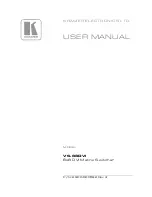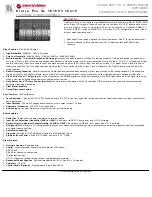
Publication date: Nov, 2014
Revision A1.1
36
COMPLIANCES
10BASE-T
IEEE 802.3 specification for 10 Mbps Ethernet over two pairs of
Category 3, 4, or 5 UTP cable
100BASE-TX
IEEE 802.3u specification for 100 Mbps Ethernet over two pairs
of Category 5 UTP cable
1000BASE-LH
Specification for long-haul Gigabit Ethernet over two strands of
9/125 micron core fiber cable
1000BASE-LX
IEEE 802.3z specification for Gigabit Ethernet over two strands
of 50/125, 62.5/125 or 9/125 micron core fiber cable.
1000BASE-SX
IEEE 802.3z specification for Gigabit Ethernet over two strands
of 50/125 or 62.5/125 micron core fiber cable.
1000BASE-T
IEEE 802.3ab specification for Gigabit Ethernet over 100-ohm
Category 5, 5e or 6 twisted-pair cable (using all four wire pairs).
AUTO-
NEGOTIATION
Signaling method allowing each node to select its optimum
operational mode (e.g., speed and duplex mode) based on the
capabilities of the node to which it is connected.
BANDWIDTH
The difference between the highest and lowest frequencies
available for network signals. Also synonymous with wire speed,
the actual speed of the data transmission along the cable.
COLLISION DOMAIN
Single CSMA/CD LAN segment.
CSMA/CD
CSMA/CD (Carrier Sense Multiple Access/Collision Detect) is
the communication method employed by Ethernet, Fast
Ethernet, and Gigabit Ethernet.
END STATION
A workstation, server, or other device that does not forward
traffic.
ETHERNET
A network communication system developed and standardized
by DEC, Intel, and Xerox, were using baseband transmission,
CSMA/CD access, logical bus topology, and coaxial cable. The
successor IEEE 802.3 standard provides for integration into the
OSI model and extends the physical layer and media with
repeaters and implementations that operate on fiber, thin coax
and twisted-pair cable.
FAST ETHERNET
A 100 Mbps network communication system based on Ethernet
and the CSMA/ CD access method.



































